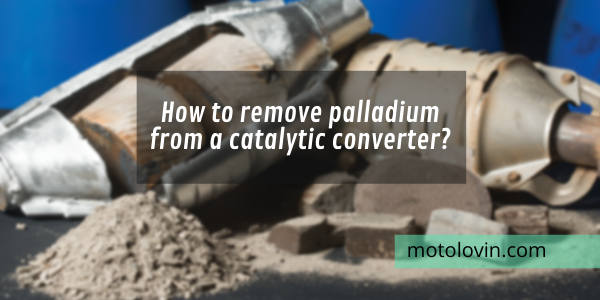Welcome to our automotive expertise column, where we provide practical solutions to common car-related problems. Today, we delve into a topic that has gained significant attention in recent years – how to remove palladium from a catalytic converter. As precious metal prices soar and the demand for recycling catalytic converters increases, understanding the process of extracting palladium becomes crucial. In this article, we will guide you through the steps, tools, and techniques involved in safely and efficiently removing palladium from your catalytic converter.
How to remove palladium from a catalytic converter
Removing palladium from a catalytic converter requires precision and careful handling. To extract this precious metal, you will need to employ a combination of mechanical and chemical processes. By following these steps, you can maximize the potential value of your catalytic converter:
- Prepare the Catalytic Converter for Extraction:
Safely remove the catalytic converter from the vehicle.Ensure proper ventilation and use protective gear, including gloves and a mask, due to the potential presence of harmful substances.
- Dismantle the Catalytic Converter:
Use appropriate tools such as a reciprocating saw or a specialized catalytic converter cutter to carefully dismantle the unit.Take note of the different components, as the palladium is primarily located within the catalytic substrate.
- Physical Extraction:
After dismantling, extract the catalytic substrate from the converter housing.
Utilize a hammer or other suitable mechanical means to crush the substrate into smaller pieces, facilitating subsequent chemical extraction.
- Chemical Extraction:
Choose an appropriate palladium extraction method based on the equipment and resources available to you. Some common methods include:
Acidic leaching: Using a suitable acid solution, dissolve the crushed substrate and separate the palladium from other materials.
Pyrometallurgical process: Employ high temperatures to melt the substrate, allowing for the separation of palladium.
Hydrogenation process: Utilize hydrogen gas to convert palladium into a soluble compound, enabling its extraction.
Purification and Recovery:
Once the palladium is separated, it requires purification to remove impurities and achieve a higher level of quality.
Various refining techniques, such as precipitation, filtration, and electrochemical methods, can be employed to purify the extracted palladium.
It is important to note that the palladium extraction process can be complex and potentially hazardous if not executed with the necessary precautions. Consider consulting with professionals or companies specializing in catalytic converter recycling for guidance and assistance.
Statistical Information:
According to industry data, palladium prices have experienced a significant surge in recent years. In 2022 Nov, palladium reached a record-high price of over $2,800 per ounce, making it an attractive target for recycling and extraction efforts. With an estimated 80-85% of the world’s palladium supply used in catalytic converters, the potential value of extracted palladium from these devices is substantial.
Having understood the process of removing palladium from a catalytic converter, it is important to approach this task with the utmost care and respect for safety. While extracting palladium can be a rewarding endeavor, it requires proper knowledge, tools, and precautions. By following the outlined steps and seeking guidance from professionals, you can navigate the process of palladium extraction effectively and responsibly. Remember, safety should always be a priority when dealing with potentially hazardous materials.
What Can One Do with Palladium from a Catalytic Converter
After successfully extracting palladium from a catalytic converter, you may wonder what you can do with this valuable precious metal. Palladium has a range of applications and can be utilized in various industries. Here are some options for putting your extracted palladium to good use:
Sell it to Precious Metal Refineries:
Palladium holds significant value in the market, and there are specialized precious metal refineries that purchase this metal.
Research and contact reputable refineries to obtain the best price for your extracted palladium.
Engage in Palladium Investment:
Consider holding onto your extracted palladium as an investment. The demand for palladium continues to rise, and its value may appreciate over time.
Consult with a financial advisor to understand the potential benefits and risks of investing in precious metals.
Contribute to Palladium Recycling Programs:
Join initiatives that promote the recycling and responsible disposal of catalytic converters.
By providing your extracted palladium to these programs, you contribute to the conservation of natural resources and the reduction of environmental impact.
Support Jewelry Manufacturing:
Palladium is a popular alternative to other precious metals in jewelry production.
If you have a substantial quantity of extracted palladium, you can explore partnering with jewelry manufacturers or artisans to create unique pieces.
Collaborate with Industrial Applications:
Palladium finds application in various industrial sectors, including electronics, dentistry, and chemical manufacturing.
Connect with companies or organizations involved in these industries to explore potential partnerships or opportunities for utilizing your extracted palladium.
Research and Development:
Palladium is used in catalytic processes and plays a vital role in reducing harmful emissions from vehicles and industrial operations.
Consider collaborating with research institutions or organizations focused on developing more efficient and sustainable catalytic technologies.
The market value of palladium fluctuates, and the best course of action may depend on current market conditions and personal preferences. It is advisable to conduct thorough research and seek expert advice before making any decisions regarding the use or sale of extracted palladium.
Final Words
In conclusion, the extraction of palladium, rhodium etc from a catalytic converter opens up several possibilities. Whether you choose to sell it, invest, recycle, support jewelry manufacturing, collaborate with industrial applications, or contribute to research and development, the extracted palladium holds value and can make a positive impact in various sectors.
